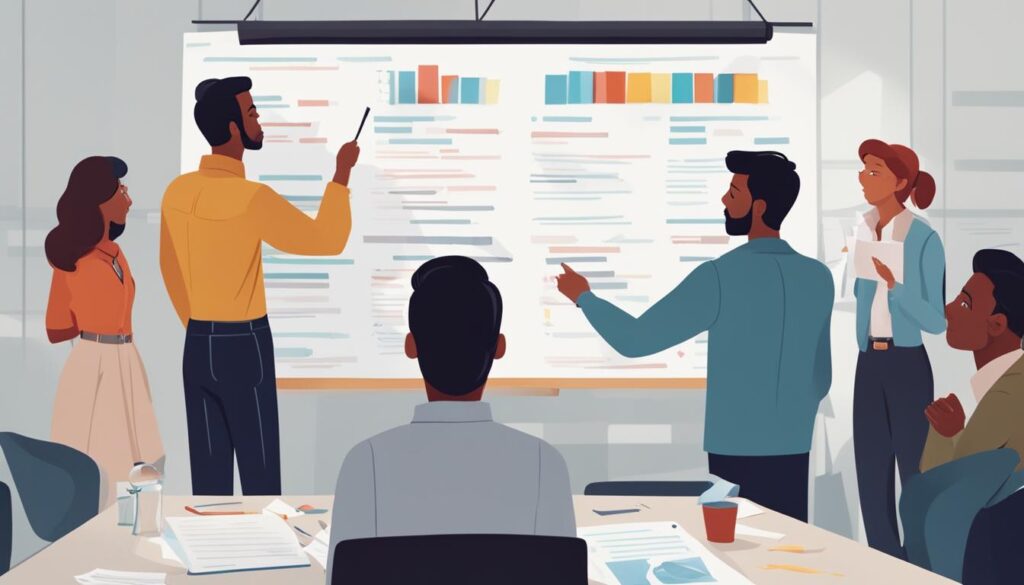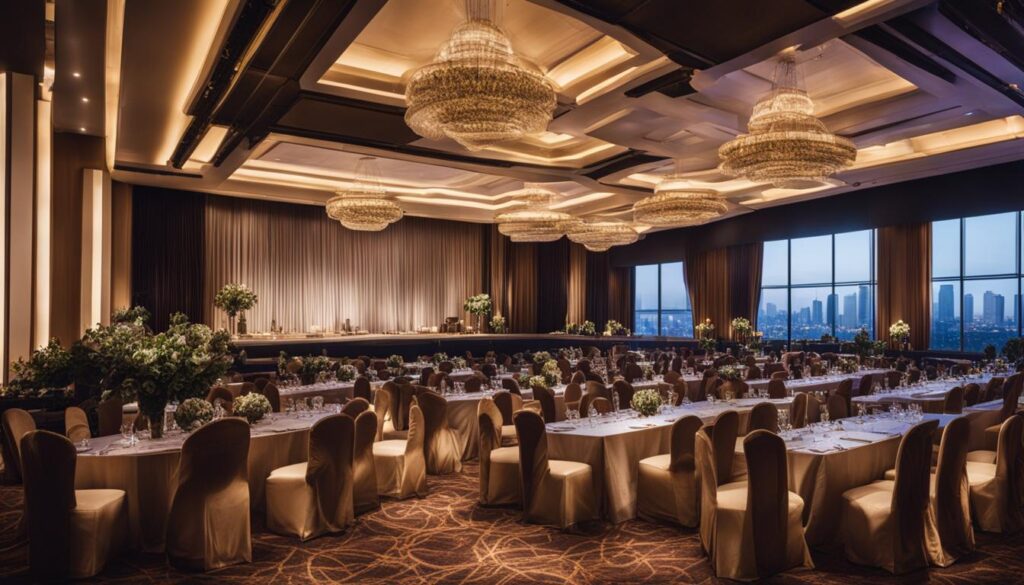We may earn money or products from the companies mentioned in this post.
If you’re looking to expand your professional network, organizing networking sessions can be an effective strategy. However, planning and executing a successful networking event requires careful planning, attention to detail, and creativity. In this comprehensive guide, we will provide you with expert tips and strategies on networking session planning to make your event a success.
Key Takeaways:
- Networking sessions are crucial for professional growth.
- Defining clear objectives is essential to ensure a successful networking event.
- An engaging agenda can help facilitate meaningful conversations.
- Innovative activities can add excitement and value to your networking session.
- Careful planning and logistical coordination are key to a seamless experience for attendees.
Understanding the Importance of Networking Sessions
In today’s fast-paced business world, effective networking strategies are integral to professional growth. Networking sessions provide a platform to build and nurture long-term relationships with clients, peers, and industry leaders. Attending networking events helps individuals stay updated on current trends, expand their knowledge base, and gain valuable insights into the industry.
Networking sessions also offer opportunities to connect with like-minded individuals, exchange ideas, and collaborate on ventures that can lead to success. Effective networking strategies such as active listening, clear communication, and follow-up can help individuals foster productive relationships that can boost their careers.
By attending networking sessions and building meaningful relationships, individuals can create a strong network of contacts that can help them achieve their career goals. Networking session benefits include access to industry-specific resources, exposure to new job opportunities, and enhanced visibility within the industry.
Defining Your Networking Session Objectives
When it comes to networking event management, the first step is to define clear objectives. Without a solid plan in place, it will be difficult to achieve your desired outcomes and ensure a productive and efficient networking session.
Here are some tips to help you plan networking sessions that meet your goals:
- Define the purpose of your networking session. Is it to generate new business leads? To foster relationships with existing clients? To promote your brand or product?
- Identify your target attendee demographics. Who do you want to attract to your event? What industries or professions should they represent?
- Set measurable goals. What specific outcomes do you want to achieve? For example, how many business cards do you want to collect? How many attendees do you want to convert into clients?
- Plan your networking sessions with a specific action plan in mind. For example, if your objective is to generate new business leads, consider including a speed networking session where attendees rotate tables to introduce themselves.
By keeping these ideas in mind, you can create networking events that are tailored to your goals and target audience, setting yourself up for success.
Designing an Engaging Networking Session Agenda
An engaging networking session requires an agenda that captures attendees’ attention and encourages interaction. The right structure can help facilitate meaningful conversations and create a valuable networking experience. Here are some tips to help you create an effective networking session agenda:
1. Start with Networking Icebreakers
Introduce attendees to each other and set a positive tone for the event by incorporating icebreakers into your agenda. You can ask attendees to introduce themselves to the group, or get creative with activities like “speed networking” or “find someone who.”
2. Allow for Open Networking Time
While it’s important to have a structured agenda, it’s also essential to allow ample time for attendees to network freely. Consider scheduling breaks or setting up designated areas for small group discussions throughout the event.
3. Focus on Value-Driven Sessions
Make sure that each session on your agenda provides value to attendees. Incorporate topics that are relevant to them and provide actionable insights. If possible, include speakers or panelists who can share their expertise and provide a fresh perspective.
4. Include Interactive Activities
Incorporate interactive activities into your agenda to keep attendees engaged and interested. These activities can include group brainstorming sessions, roundtable discussions, or even games related to the event’s theme.
5. End with a Strong Call to Action
End your networking session with a clear call to action that encourages attendees to follow up and continue the connections they’ve made. This could include providing attendees with contact information for the event’s speakers or panelists and encouraging them to reach out for further discussion.
With these tips, you can design an effective networking session agenda that encourages interaction, fosters relationships, and provides lasting value. Keep in mind that the agenda should align with your networking session objectives and target attendees, and always be open to feedback and adjustments to ensure a successful event.
Innovative Networking Session Activities
Networking sessions can be an excellent opportunity to meet new people, make connections, and expand your professional network. However, networking events can also be awkward and uncomfortable, leaving attendees feeling bored and disengaged. As a networking session planner, it’s your job to create an environment that encourages interaction and meaningful conversation. One way to do this is to incorporate innovative networking activities that break the ice and foster connections.
Speed Networking
Speed networking is a fast-paced activity that allows attendees to meet and connect with multiple people in a short amount of time. Participants are paired with one another and given a set time limit, usually around two minutes, to introduce themselves and exchange information. After the time is up, participants move on to the next person, repeating the process. This activity is a great way to get attendees talking and can lead to some valuable connections.
Networking Scavenger Hunt
A networking scavenger hunt is a fun and creative way to get attendees interacting with one another and exploring the event space. To play, provide attendees with a list of items or tasks to complete, such as finding someone who works in a specific industry or taking a photo with someone wearing a specific color. Participants must work together to complete the list and can use the opportunity to strike up conversations and make new connections.
Roundtable Discussions
Roundtable discussions are a great way to encourage meaningful conversation and collaboration among attendees. Divide participants into small groups and assign each group a specific topic related to the event theme. Participants can then share their thoughts and ideas, ask questions, and offer suggestions. This activity not only encourages engagement but also provides attendees with valuable insights and perspectives.
- Note: It’s essential to assign a facilitator for each group to ensure the conversation stays on topic and that everyone has a chance to participate.
Interactive Workshops
Interactive workshops are an excellent activity for networking sessions focused on professional development or specific skills. These workshops can include hands-on activities, group exercises, or presentations. Attendees can learn new skills, share their expertise, and make new connections based on their mutual interests.
Incorporating innovative networking activities into your networking sessions can make your event stand out and be more memorable. These activities can create a fun and engaging atmosphere that encourages attendees to connect and collaborate, ultimately leading to increased professional growth.
Managing Networking Session Logistics
Organizing a successful networking event requires meticulous planning and effective management of logistics. Here are some key factors to consider:
Venue Selection
Choose a location that is easily accessible and suitable for your event size and format. Consider factors such as seating capacity, AV equipment, and catering options. Don’t forget to negotiate the best rates for the venue and services provided.
Registration Processes
Streamline the registration process with an efficient online platform. Make sure the registration form collects all necessary information, such as attendee names, company affiliations, and contact details. Set clear deadlines for registration and send regular reminders to ensure maximum attendance.
Audiovisual Setup
Ensure that all necessary AV equipment such as microphones, speakers, and projectors are tested and set up before the event. Make sure to have backup equipment on-site in case of technical issues. Additionally, consider providing a reliable internet connection for attendees to access online resources or participate in virtual networking sessions.
Networking Session Flow
Structure your networking session to facilitate maximum interaction and engagement among attendees. Use icebreakers, group activities, or speed networking sessions to encourage conversations and develop connections. Additionally, consider providing water or refreshments during the session to keep attendees refreshed and energized.
Networking Event Feedback
After the event, collect feedback from attendees to gauge their satisfaction and identify areas for improvement. Send out a survey or use an online feedback form to gather responses. Analyze the feedback and use it to improve your next networking event.
Conclusion
Networking sessions are a powerful tool for professional growth, and with careful planning and execution, they can be incredibly valuable. By following the expert advice and strategies outlined in this guide, you can elevate your networking events, create meaningful connections, and boost your career growth.
Remember, the key to successful networking session planning is to define clear objectives, design engaging agendas, and provide innovative activities that foster connections. Additionally, managing logistics to ensure a seamless experience for attendees is crucial.
Elevate Your Networking Game
Networking session planning requires time, effort, and dedication, but the results are well worth it. With the tips and strategies shared in this guide, you can take your networking game to the next level and enjoy the many benefits that networking sessions offer.
Whether you’re organizing a small gathering or a large-scale event, focus on creating a positive and valuable experience for attendees by providing ample opportunities for interaction, fostering relationships, and cultivating a productive networking environment.
FAQ
What are networking sessions?
Networking sessions are events or gatherings where professionals come together to meet, connect, and build relationships with others in their industry or field.
Why are networking sessions important?
Networking sessions are important because they provide opportunities for professionals to expand their network, exchange knowledge and ideas, and potentially discover new career opportunities.
How can I plan a successful networking session?
To plan a successful networking session, it’s important to define clear objectives, identify target attendees, design an engaging agenda, incorporate innovative activities, and efficiently manage logistics.
What should be included in a networking session agenda?
A networking session agenda should include opportunities for introductions, structured networking activities, educational or informative sessions, and time for open networking.
What are some innovative networking session activities?
Some innovative networking session activities include speed networking, group discussions or panels, interactive workshops, icebreaker games, and networking challenges.
How can I manage the logistics of a networking session?
To manage the logistics of a networking session, you should carefully select a suitable venue, establish a streamlined registration process, ensure proper audiovisual setup, and consider factors like food and beverage arrangements.
Affiliate Disclosure: This post may contain affiliate links. If you purchase through our link, we may receive a small commission, but at no additional cost to you. For more information, please see our Disclosure statement.



